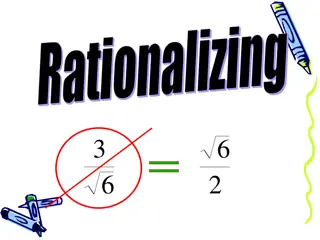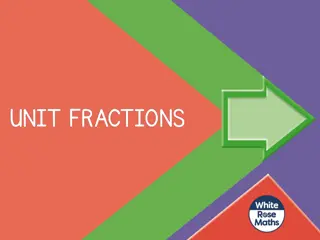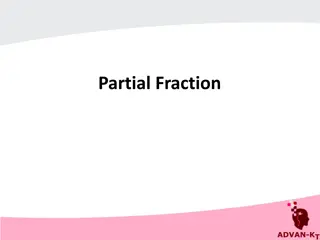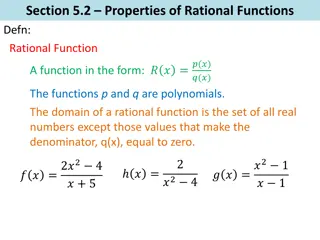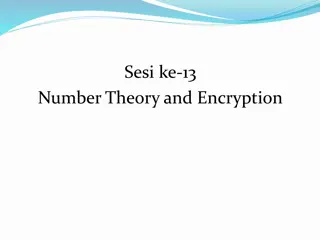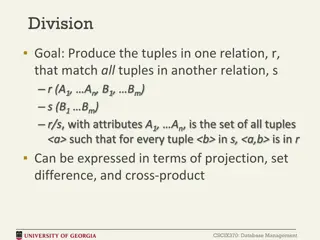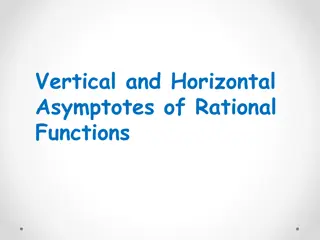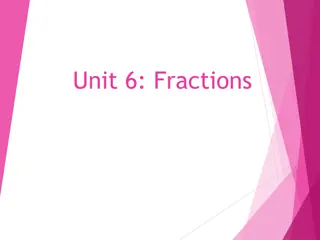Rationalizing in Mathematics
Discover the essential concept of rationalizing in mathematics, focusing on not leaving radicals in the denominator of a fraction. Learn how to change the denominator of a fraction without altering its value by multiplying the numerator and denominator by the same number. Explore the process of rati
2 views • 18 slides
Fractions and Shaded Shapes
Explore fractions by identifying shaded parts in different shapes. Learn about unit fractions with a numerator of 1, and practice determining fractions of shaded areas. Understand the concept of unit fractions and apply it to various scenarios involving shapes and fractions.
0 views • 21 slides
Partial Fraction Decomposition
The partial fraction decomposition method is a powerful technique used to simplify rational functions by breaking them into simpler fractions. It involves reducing the degree of either the numerator or the denominator. Learn about proper and improper fractions, simple and repeated factors, and how t
2 views • 17 slides
Properties of Rational Functions
Rational functions are expressed as the ratio of two polynomials. The domain of a rational function excludes values that make the denominator zero. Various examples illustrate how to determine the domain and identify asymptotes in rational functions. Vertical asymptotes exist where the denominator i
5 views • 20 slides
Fractions through Shaded Shapes
Explore different fractions by looking at shaded shapes. Identify shapes with one half, one third, and one quarter shaded. Learn about unit fractions with a numerator of 1 and practice visualizing fractions with various shaded parts.
3 views • 21 slides
Basics of Division in Number Theory and Encryption
Understanding arithmetic operations for discrete numbers is crucial in the world of Number Theory and Encryption. This session covers the fundamentals of addition, subtraction, multiplication, and division, emphasizing key terms like dividend, numerator, divisor, quotient, remainder, and fraction. T
0 views • 7 slides
Division in Relational Algebra
Division in relational algebra is a fundamental operation used to produce tuples in one relation that match all tuples in another relation based on certain conditions. It involves expressing the desired result in terms of projection, set difference, and cross-product operations. The process ensures
0 views • 13 slides
Turning Negative Exponents into Positive Exponents Explained
Learn how to convert negative exponents into positive exponents by identifying the placement of negatives in the numerator or denominator, and moving the exponent accordingly. Follow these simple steps to master this fundamental math concept easily.
0 views • 4 slides
Vertical and Horizontal Asymptotes in Rational Functions
Vertical and horizontal asymptotes play a crucial role in understanding the behavior of rational functions. Vertical asymptotes occur when the denominator of a rational function equals zero, leading to excluded values. On the other hand, horizontal asymptotes are determined by comparing the degrees
0 views • 13 slides
Equivalent Fractions: Modeling and Analysis
Delve into the world of equivalent fractions by choosing one from the provided denominator and numerator ratio, finding five additional equivalent fractions, recording them in a data table, and graphing the results. An in-depth reflection explores similarities and differences between graphs, determi
0 views • 5 slides
Understanding Fractions: Basics to Conversion Techniques
Dive into the world of fractions, learning about numerator, denominator, equivalent fractions, simplifying, fractions greater than 1, and converting between improper fractions and mixed numbers. Explore real-life examples and non-examples to grasp the concept easily.
0 views • 16 slides
